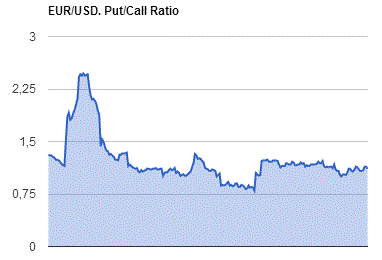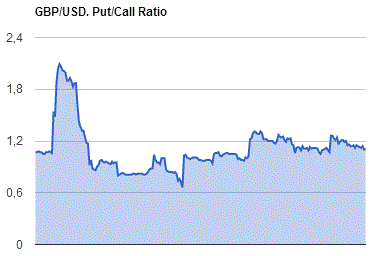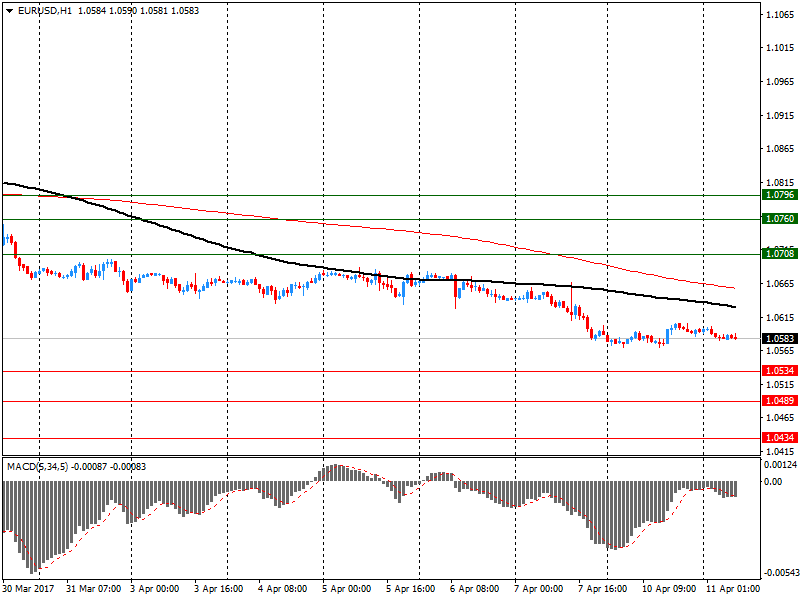Market news
-
23:51
Japan: Core Machinery Orders, February 1.5% (forecast 3.7%)
-
23:51
Japan: Core Machinery Orders, y/y, February 5.6% (forecast 2.5%)
-
22:27
Currencies. Daily history for Apr 11’2017:
(pare/closed(GMT +2)/change, %)
EUR/USD $1,0605 +0,11%
GBP/USD $1,2490 +0,58%
USD/CHF Chf1,0071 -0,13%
USD/JPY Y109,59 -1,16%
EUR/JPY Y116,20 -1,07%
GBP/JPY Y136,85 -0,58%
AUD/USD $0,7496 -0,08%
NZD/USD $0,6955 -0,10%
USD/CAD C$1,3323 -0,04%
-
22:02
Schedule for today,Wednesday, Apr 12’2017 (GMT0)
00:30 Australia Westpac Consumer Confidence April 99.7
01:30 China PPI y/y March 7.8% 7.6%
01:30 China CPI y/y March 0.8% 1%
08:00 United Kingdom BOE Gov Mark Carney Speaks
08:30 United Kingdom Average Earnings, 3m/y February 2.2% 2.2%
08:30 United Kingdom ILO Unemployment Rate February 4.7% 4.7%
08:30 United Kingdom Claimant count March -11.3 -3
09:00 China New Loans March 1170 1200
12:30 U.S. Import Price Index March 0.2% -0.2%
14:00 Canada Bank of Canada Rate 0.5% 0.5%
14:00 Canada BOC Rate Statement
14:00 Canada Bank of Canada Monetary Policy Report
14:00 U.S. FOMC Member Kaplan Speak
14:30 U.S. Crude Oil Inventories April 1.566
15:15 Canada BOC Press Conference
18:00 U.S. Federal budget March -192 -150
20:15 Canada BOC Gov Stephen Poloz Speaks
22:30 New Zealand Business NZ PMI March 55.2
22:45 New Zealand Food Prices Index, y/y March 2.2%
-
14:00
U.S.: JOLTs Job Openings, February 5.743 (forecast 5.655)
-
13:55
Putin says we will tolerate western criticism of our role in Syria
-
We hope that eventually attitudes will become more positive
-
U.S strike on Syria reminds him of WMD claims in Iraq
-
Russia has information that strikes being readied on Damascus region with aim of blaming Syrian govt
-
-
13:42
Option expiries for today's 10:00 ET NY cut
EURUSD:1.0500 (EUR 221m) 1.0550 (230m) 1.0600 (556) 1.0625 (193m) 1.0650-60 (452m) 1.0700-05 (535m) 1.0755-60 (641m)
USDJPY: 110.00 (USD 300m) 1110.45-55 (457m) 110.70-75 (USD 650m) 111.00-10 (USD 570m) 111.45-50 (565m) 111.75-80 (300m) 111.85-112.00 (1.03bln)
GBPUSD: 1.2400-10 (GBP 260m)
USDCHF: 1.0115-25 (USD 180m)
AUDUSD: 0.7520-30 (AUD 520m) 0.7550 (306m) 0.7620-25 (577m)
USDCAD: 1.3215 (USD 210m) 1.3305 (220m)
-
13:18
Russia's Putin says has heard U.S is preparing strikes on southern Damascus suburbs
-
12:34
I explained to the President of China that a trade deal with the U.S. will be far better for them if they solve the North Korean problem! @realDonaldTrump
-
11:58
Orders
EUR/USD
Offers: 1.0600-05 1.0630 1.0650 1.0670 1.0685 1.0700
Bids: 1.0580 1.0565 1.0550 1.0530 1.0500 1.0485 1.0465 1.0450
GBP/USD
Offers: 1.2430 1.2450 1.2465 1.2480 1.2500 1.2520 1.2550-55 1.2500
Bids: 1.2380-85 1.2350 1.2330 1.2300 1.2285 1.2250
EUR/JPY
Offers: 118.00 118.30 118.50 118.65 118.80 119.00
Bids: 117.65 117.50 117.30 117.00 116.85 116.50 116.00
EUR/GBP
Offers: 0.8550-55 0.8580 0.8600 0.8630 0.8650
Bids: 0.8520 0.8500 0.8485 0.8465 0.8450 0.8430 0.8400
USD/JPY
Offers: 110.75-80 111.00 111.30 111.50 111.65 111.80 112.00
Bids: 110.45-50 110.25-30 110.00 109.80 109.50 109.00
AUD/USD
Offers: 0.7520-25 0.7550 0.7565 0.7580 0.7600
Bids: 0.7480-85 0.7465 0.7450 0.7425-30 0.7400
-
10:45
French foreign minister says no agreement at G7 to broaden sanctions on Russia and Syria
-
10:32
French foreign minister says vital to have ceasefire in Syria monitored by international community as first step
-
All G7 nations agree Assad cannot be part of Syria's future
-
G7 will tell Russia it must not be hypocritical and must accept its responsibilities in Syria
-
-
09:52
Russia's Central bank 1st Dep Governor Yudayeva, on possible further key rate cut, says inflation data is promising so far
-
We will evaluate all data ahead of key rate meeting
-
Inflation target of 4 pct could be reached significantly earlier than planned
-
-
09:09
The German economic situation has proved fairly robust in the first quarter says ZEW president Achim Wambach
The ZEW Indicator of Economic Sentiment for Germany increased substantially by 6.7 points in April 2017. The indicator now stands at 19.5 points, thereby reaching its highest level since August 2015. Though the long-term average as calculated from the beginning of the survey (December 1991) is yet to be beaten, these results are comparable to the expectations prior to the Brexit vote in June 2016.
"The German economic situation has proved fairly robust in the first quarter. This is highlighted by the solid figures for growth in industrial production, the construction sector and retail sales from February. In addition, the consistently high labour demand has boosted private consumption. The financial market experts expect this positive development to continue," comments ZEW President Professor Achim Wambach .
-
09:08
Industrial production fell by 0.3% in the euro area (EA19) and by 0.2% in the EU28
In February 2017 compared with January 2017, seasonally adjusted industrial production fell by 0.3% in the euro area (EA19) and by 0.2% in the EU28, according to estimates from Eurostat, the statistical office of the European Union. In January 2017 industrial production rose by 0.3% in both zones. In February 2017 compared with February 2016, industrial production increased by 1.2% in the euro area and by 2.1% in the EU28.
The decrease of 0.3% in industrial production in the euro area in February 2017, compared with January 2017, is due to production of energy falling by 4.7% and non-durable consumer goods by 1.1%. Production of durable consumer goods remained stable, while capital goods rose by 0.9% and intermediate goods by 1.0%. In the EU28, the decrease of 0.2% is due to production of energy falling by 3.9% and non-durable consumer goods by 0.9%, while production of durable consumer goods rose by 0.4% and both capital goods and intermediate goods by 0.8%. Among Member States for which data are available, the largest decreases in industrial production were registered in Ireland (-15.5%), France (-1.6%) and Croatia (-1.5%), and the highest increases in Bulgaria and Slovenia (both +3.6%), Hungary (+3.4%) and Latvia (+3.2%).
-
09:01
Eurozone: ZEW Economic Sentiment, April 26.3 (forecast 25)
-
09:00
Eurozone: Industrial Production (YoY), February 1.2% (forecast 2%)
-
09:00
Eurozone: Industrial production, (MoM), February -0.3% (forecast 0.1%)
-
09:00
Germany: ZEW Survey - Economic Sentiment, April 19.5 (forecast 14)
-
08:40
UK housing market indicators for February suggested slowing demand and continued tight supply
UK House prices grew by 5.8% in the year to February 2017, 0.5 percentage points higher than January 2017. However this still remains below the average annual house price growth seen in 2016 which was 7.3%.
In terms of housing demand the Royal Institute of Chartered Surveyors' (RICS) residential market survey for February 2017 reported that housing market activity remained subdued. Transaction volumes and new buyer enquiries are broadly unchanged since November 2016. Despite this, RICS expect near term price expectations to remain positive, albeit steady.
RICS' new buyer enquiries figures are supported by the Bank of England approvals for lending secured on dwellings for February 2017 which showed that the volume of approvals for house purchase decreased by 5.6% compared to February 2016.
-
08:39
UK annual rate of producer price inflation fell back slightly in March
Factory gate prices (output prices) rose 3.6% on the year to March 2017, from 3.7% in February 2017, which is the ninth consecutive period of annual price growth.
Prices for materials and fuels which are paid by UK manufacturers for processing (input prices) rose 17.9% on the year, which is a slight decrease from February 2017; this is the ninth consecutive period of annual price growth.
Prices of imported materials and fuels increased 17.1% on the year to March 2017, which is the second consecutive month inflation from imported materials and fuels has been lower than total inputs.
A recent spike in export prices following the depreciation of sterling resulted in a boost to export turnover for manufacturers of motor vehicles, trailers and semi-trailers.
-
08:38
UK Consumer Prices Index was 2.3% in March
The Consumer Prices Index including owner occupiers' housing costs (CPIH, not a National Statistic) 12-month inflation rate was 2.3% in March 2017, unchanged from February.
The rate has been steadily increasing following a period of relatively low inflation in 2015.
Rising prices for food, alcohol and tobacco, clothing and footwear, miscellaneous goods and services were the main upward contributors to change in the rate.
These were largely offset by a downward contribution from transport, particularly air fares and, to a lesser extent, motor fuels.
The Consumer Prices Index (CPI) 12-month rate was also 2.3% in March 2017, unchanged from February.
-
08:37
GBP/USD rallies after strong CPI data. Up 40 pips from major support level
-
08:30
United Kingdom: HICP, Y/Y, March 2.3% (forecast 2.3%)
-
08:30
United Kingdom: HICP, m/m, March 0.4% (forecast 0.3%)
-
08:30
United Kingdom: Producer Price Index - Output (YoY) , March 3.6% (forecast 3.3%)
-
08:30
United Kingdom: HICP ex EFAT, Y/Y, March 1.8% (forecast 1.9%)
-
08:30
United Kingdom: Retail prices, Y/Y, March 3.1% (forecast 3.2%)
-
08:30
United Kingdom: Producer Price Index - Input (MoM), March 0.4% (forecast -0.2%)
-
08:30
United Kingdom: Producer Price Index - Input (YoY) , March 17.9% (forecast 17%)
-
08:30
United Kingdom: Retail Price Index, m/m, March 0.3% (forecast 0.4%)
-
08:30
United Kingdom: Producer Price Index - Output (MoM), March 0.4% (forecast 0.1%)
-
08:15
Forex option contracts rolling off today at 14.00 GMT:
EURUSD:1.0500 (EUR 221m) 1.0550 (230m) 1.0600 (556) 1.0625 (193m) 1.0650-60 (452m) 1.0700-05 (535m) 1.0755-60 (641m)
USDJPY: 110.00 (USD 300m) 1110.45-55 (457m) 110.70-75 (USD 650m) 111.00-10 (USD 570m) 111.45-50 (565m) 111.75-80 (300m) 111.85-112.00 (1.03bln)
GBPUSD: 1.2400-10 (GBP 260m)
USDCHF: 1.0115-25 (USD 180m)
AUDUSD: 0.7520-30 (AUD 520m) 0.7550 (306m) 0.7620-25 (577m)
USDCAD: 1.3215 (USD 210m) 1.3305 (220m)
-
07:13
Romanian CPI rose for the third straight month in March
Romania's consumer prices increased for the third straight month in March, figures from the National Bureau of Statistics, cited by rttnews.
The consumer price index edged up 0.2 percent year-over-year in March, the same rate of increase as in February.
Grocery prices grew 1.7 percent annually in March, while costs for services dropped by 1.4 percent. Non-food prices also registered a decline of 0.2 percent.
Month-on-month, consumer prices edged up 0.1 percent in March.
-
07:06
Russian rouble opens unchanged vs dollar at 57.15
-
06:42
Options levels on tuesday, April 10, 2017
EUR/USD
Resistance levels (open interest**, contracts)
$1.0796 (630)
$1.0760 (1074)
$1.0708 (462)
Price at time of writing this review: $1.0583
Support levels (open interest**, contracts):
$1.0534 (746)
$1.0489 (1672)
$1.0434 (2675)
Comments:
- Overall open interest on the CALL options with the expiration date June, 9 is 51615 contracts, with the maximum number of contracts with strike price $1,1000 (4371);
- Overall open interest on the PUT options with the expiration date June, 9 is 55937 contracts, with the maximum number of contracts with strike price $1,0400 (5347);
- The ratio of PUT/CALL was 1.08 versus 1.13 from the previous trading day according to data from April, 10

GBP/USD
Resistance levels (open interest**, contracts)
$1.2707 (604)
$1.2610 (380)
$1.2514 (960)
Price at time of writing this review: $1.2415
Support levels (open interest**, contracts):
$1.2289 (636)
$1.2192 (548)
$1.2094 (625)
Comments:
- Overall open interest on the CALL options with the expiration date June, 9 is 15639 contracts, with the maximum number of contracts with strike price $1,3000 (1198);
- Overall open interest on the PUT options with the expiration date June, 9 is 17488 contracts, with the maximum number of contracts with strike price $1,1500 (3063);
- The ratio of PUT/CALL was 1.12 versus 1.08 from the previous trading day according to data from April, 10

* - The Chicago Mercantile Exchange bulletin (CME) is used for the calculation.
** - Open interest takes into account the total number of option contracts that are open at the moment.
-
06:16
Japan: Prelim Machine Tool Orders, y/y , March 22.6%
-
05:58
Australia, Canada, New Zealand and Sweden are exposed to a potential housing market correction - Moody's
Moody's Investors Service says that Australia, Canada, New Zealand and Sweden -- all rated Aaa stable -- are exposed, through different channels and to varying degrees, to a potential housing market correction.
However, unless the reversals in house prices were accompanied by other long-lasting negative shocks, they would not fundamentally undermine the sovereigns' credit profiles.
Moody's notes that all four countries have strong banking systems with high capitalization levels, conservative business models and strong liquidity, which lower the sovereigns' banking system-related contingent liability risks. Such contingent liabilities were among the highest costs of housing crises elsewhere.
Moody's conclusions were contained in its just-released report, "Sovereigns -- Advanced Economies: Credit Profiles Resilient to Rising Household Debt and Stretched Housing Affordability."
The report focuses on the four countries that have experienced the largest increases, among advanced economies, in house prices and household debt over the last three years. House prices rose by more than 30% in real terms in New Zealand and Sweden and by approximately 20% in real terms in Canada and Australia. In all four cases, these increases have been accompanied by higher household leverage.
In the event of a reversal in house price gains or other economic or financial shocks, higher household debt levels raise the risk of consumer retrenchment and imply higher likelihood of stress in the banking system, all else being equal.
-
05:56
Yellen says Fed independence 'is under some threat' from congressional bills. “Don't want to have to raise rates rapidly”
-
Fed policy independence from political pressure very important
-
Economy's growth potential is likely a bit below 2 pct
-
Inflation still slightly below 2 pct goal
-
We think gradual path of rate hikes will get fed to neutral policy stance; can't wait too long to tighten
-
We are near reaching objectives
-
Appropriate policy stance is closer to neutral now
-
Fed aims to allow economy to coast
-
Economy mainly supported by consumer spending
-
Global economy seems to be operating in slightly more robust way
-
-
05:53
BoJ Gov Kuroda: too early to say what BoJ will do with purchases of super long-term JGBs
-
Will be able to manage policy appropriately, including raising rates on excess reserves and shrinking balance sheet
-
Level of rates and size of balance sheet will be topics for exit strategy
-
Want gains in earnings and wages to accompany gains in consumer prices
-
-
05:15
Russian foreign ministry says US missile strike is a aggressive act, violates international law - RIA
-
Lavrov discussed Syria with his Iranian counterpart
-
-
01:46
Australia: National Australia Bank's Business Confidence, March 6
-

